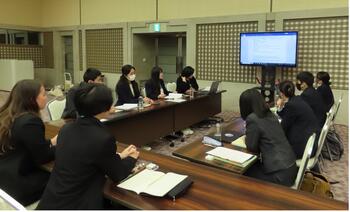My Experience at the G7 Hiroshima Junior Conference
My Experience at the G7 Hiroshima Junior Conference
Stanford e-Japan alumna Sarah Sumire Nomoto shares her experience as a youth representative at the G7 Hiroshima Junior Conference.

The following is a guest post written by Sarah Sumire Nomoto, who participated in the G7 Hiroshima Junior Conference in Hiroshima Prefecture. Sarah was a participant of the fall 2022 Stanford e-Japan course, which was taught by Meiko Kotani.
I am Sarah Sumire Nomoto. I am 17 years old, and I was born and raised in Hiroshima. My father is American, and my mother is Japanese. In this post, I would like to share thoughts on my experiences at the G7 Hiroshima Junior Conference, which was held from March 27th to 30th, 2023, and was organized by the Citizens Council for the Hiroshima Summit.
In advance of the G7 Summit in Hiroshima, this conference had the aim to have young people from the G7 countries come together to consider, discuss, and deepen understanding about international issues and initiatives and forge a resolution from the perspective of youth. There were 24 high school students participating, including 12 Japanese students from Hiroshima Prefecture and 12 students from the remaining G7 countries: France, the U.S., the U.K., Germany, Italy, and Canada. We were divided into three groups: (1) Peace; (2) Sustainability; (3) Diversity and Inclusion. Because of my background as a Japanese American living in Japan and my mother’s involvement in LGBTQ+ issues in Japan, I have been interested in the topic of diversity from an early age, which led me to join the diversity group.
On the first day, we went to the Hiroshima Peace Memorial Park and Museum and listened to a story from a hibakusha (atomic bomb survivor)—something I have experienced many times as a student in Hiroshima. I knew from the Stanford e-Japan program that American students are usually taught the reasons of the bombings, but little of the impact. Then, I saw a lot of G7 country participants getting shocked by the hibakusha’s story and the museum exhibits. After this experience, we talked together about finding the difference between “knowing” and “realizing.” This was exactly the point I had tried to make in my Stanford e-Japan research paper which was coming true in front of me at the G7 Hiroshima Junior Conference.

The second day marked the start of our group’s focus on the theme of diversity. We went on a study tour which was meant to broaden our cultural horizons. However, we learned and realized that Japanese societal views are often limited to cultural and ethnic diversity, and other critical issues such as gender equality, LGBTQ+ rights, disabilities, and generational differences are less discussed. We felt that the perspectives of how our society sees diversity and inclusion must be expanded.
On the third day, as youth representatives of the G7 countries, we presented our final outcome to Hiroshima Prefecture Governor Hidehiko Yuzaki. We recommended and demanded that youth play key roles in the discussions surrounding diversity and inclusion, as there are many crucial issues that must be addressed now. When we talked about and created our document, I realized how valuable the Stanford e-Japan program had been in preparing me to be involved in discussions like this.
I am currently doing the International Baccalaureate program in high school, and my dream is to raise people’s awareness of global issues through film production. I would like to continue my efforts based on what I have learned at this conference and through Stanford e-Japan.



